18th Zen Nihon Pro Tournament Game 1
Black: Okazaki Hiroshi, 5-dan
White: Tanigawa Koji, Kisei
18th Zen Nihon Pro Tournament, Game 1, April 5th 2000
1.P7g-7f 0/0 0/0
2.P3c-3d 0/0 2/2
3.P2g-2f 1/1 0/2
4.P8c-8d 0/1 1/3
5.P6g-6f?! 7/8 0/3
This is Okazaki's first appearance in a tournament final and the pressure
to win is completely on his vastly more experienced opponent. How would
Okazaki try to make up for this difference? It seems like he decided to
try and confuse Tanigawa in the opening. 5.P6f is an unusual move and only
regularly played by Tanaka Torahiko. It is not a bad move, but it is a little
defensive and to me this is an indication that Okazaki entered this game with
the wrong mind set.
6.P8d-8e 0/8 5/8
7.B8h-7g 0/8 0/8
8.S3a-4b 0/8 0/8
9.G4i-5h 10/18 0/8
10.S7a-6b 0/18 2/10
11.G5h-6g 1/19 0/10
12.G4a-3b 0/19 2/12
13.S3i-4h 5/24 0/12
14.K5a-4a 0/24 6/18
15.P5g-5f 14/38 0/18
16.P5c-5d 0/38 9/27
17.S7i-8h 1/39 0/27
18.S6b-5c 0/39 16/43
19.S4h-5g 14/53 0/43
20.P5d-5e?! 0/53 15/58
A positive move that is typical of Tanigawa's style of play. However, it
was probably better to wait a little longer, since this gives black a chance
to untangle the knot of pieces on the king side a little.
21.P5fx5e 25/78 0/58
22.B2bx5e 0/78 0/58
23.P6f-6e! 0/78 0/58
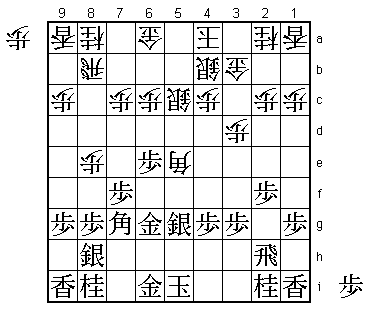
This is the problem. The exchange of the bishop is better for black than it
is for white, since black's bishop was badly positioned up to now.
24.B5e-3c 0/78 18/76
No choice. 24.Bx7g+ Sx7g only helps black.
25.K5i-6h 3/81 0/76
Not bad, but immediately 25.Bx3c+ Sx3c S7g can also be considered.
26.K4a-3a 0/81 3/79
27.K6h-7h? 1/82 0/79
This is not good. Here black should have exchanged the bishops: 27.Bx3c+ Sx3c
S7g and it is hard to say who is better. Furthermore, if black avoids the
exchange of the bishops, then 27.K7i followed by 28.G7h is the right way
to move into the Yagura castle, as it defends the upper area of the king
better.
28.P4c-4d 0/82 11/90
29.P3g-3f 3/85 0/90
30.S4b-4c 0/85 0/90
31.P2f-2e 1/86 0/90
32.P6c-6d 0/86 4/94
33.P6ex6d 0/86 0/94
34.S5cx6d 0/86 0/94
35.B7g-5i 0/86 0/94
36.G6a-5b 0/86 5/99
37.S8h-7g 1/87 0/99
38.G5b-6c 0/87 10/109
39.B5i-3g 9/96 0/109
40.G6c-5d 0/96 2/111
41.P1g-1f 3/99 0/111
42.P1c-1d 0/99 0/111
43.G6i-6h? 0/99 0/111
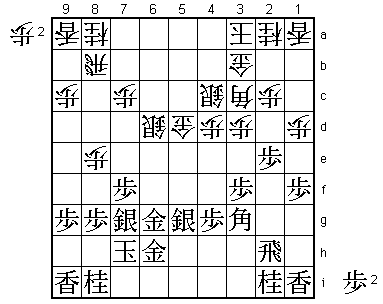
Okazaki did not want to put the king into the bishop's diagonal, but he
should have been brave here. After 43.K8h P*5e G7h G4e R6h B4b B2h black
still has good chances because black's castle is much stronger. Tanigawa
actually thought that he had messed things up because of this. After
43.G6h it is actually white that has the better castle.
44.K3a-2b 0/99 0/111
45.P9g-9f? 1/100 0/111
Another mistake in the assessment of the position. This turns out to be
a pointless waiting move.
46.P*5e 0/100 2/113
47.P4g-4f 2/102 0/113
48.P7c-7d 0/102 1/114
49.P*6f? 8/110 0/114
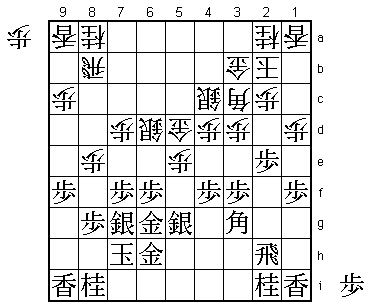
Already the fatal mistake. Okazaki should have played 49.P*6e here. After
both 50.Sx6e P*6f S5f Sx5f Px5f P4e P6d S*6c and 50.S5c S7g-6f N7c P7e
Nx6e S7f S6d Px7d P*7g Nx7g Nx7g+ G6gx7g black still has good chances.
49.P*6f is typical of Okazaki's passive play in this game.
50.P7d-7e 0/110 12/126
51.B3g-2f 8/118 0/126
52.P7ex7f 0/118 2/128
53.S7gx7f 0/118 0/128
54.P*7e 0/118 0/128
55.S7f-6e 7/125 0/128
56.S6dx6e 0/125 3/131
57.P6fx6e 1/126 0/131
58.S*7f 0/126 0/131
59.G6gx7f 5/131 0/131
60.P7ex7f 0/131 0/131
61.S5g-6f 0/131 0/131
62.P8e-8f 0/131 9/140
63.P8gx8f 0/131 0/140
64.B3c-4b 0/131 0/140
65.P*7e 1/132 0/140
66.G*5f? 0/132 11/151
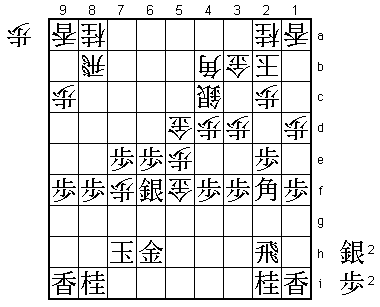
Tanigawa uncharacteristically misses the shortest route to victory here. Best
was 66.P*6d Px6d Gx6d P4e Gx7e Sx7e (Sx5e P7g+! also wins for white) Bx7e
Px4d P*6g! and white wins quickly.
67.S*6g 0/132 0/151
68.N8a-7c 0/132 0/151
69.P4f-4e 6/138 0/151
70.G5dx4e 0/138 5/156
71.S*7d 3/141 0/156
This is the move that made Tanigawa actually fear that the tables were turned
because of 66.G*5f. However, in the press room no defence for Okazaki was
discovered, so things might not have been that bad.
72.G5fx6f 0/141 4/160
73.S6gx6f 0/141 0/160
74.G4e-5f 0/141 0/160
75.G*6g 0/141 0/160
76.P*8h 0/141 0/160
77.S7dx7c+ 4/145 0/160
77.Kx8h Rx8f P*8g S*7i is also winning for white.
78.R8bx8f 0/145 2/162
79.P*8g 0/145 0/162
80.G5fx6g 0/145 0/162
81.G6hx6g 0/145 0/162
82.G*7i! 0/145 0/162
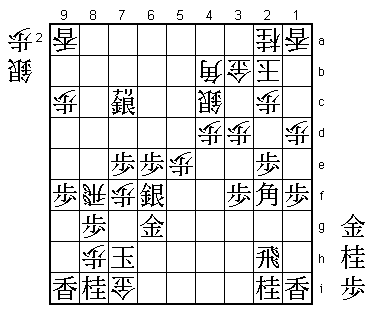
Nice move that makes clear that white is still winning.
83.K7hx8h 0/145 0/162
If 83.Kx7i then Rx8g+ G*7h Px8i+ K6i P*6h and then Kx6h or Rx6h is followed
by N*5f, while G6gx6h is followed by +R4g.
84.G7ix8i 0/145 0/162
85.K8h-9g 1/146 0/162
86.R8f-8a 0/146 0/162
87.P8g-8f 0/146 0/162
88.N*5d 0/146 0/162
89.K9g-8g 0/146 0/162
90.N5dx6f 0/146 0/162
91.G6gx6f 0/146 0/162
92.G8i-8h 0/146 2/164
93.R2hx8h 1/147 0/164
94.S*7g 0/147 0/164
Resigns 0/147 0/164
Time: 02:27:00 02:44:00
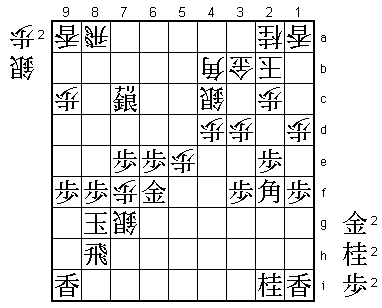
The threats Sx8h+, Sx6f+ and Rx8f are too much, so Okazaki resigned. This
game had quite a number of mistakes, but in the end was decided by Okazaki's
passive play. If he wants to have a shot at beating Tanigawa, he will have
to play more positively in the rest of the match. It will be encouraging for
him to know that he was given several chances to make a good fight of it
in this first game.





